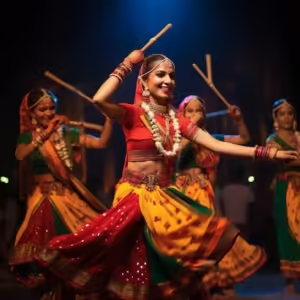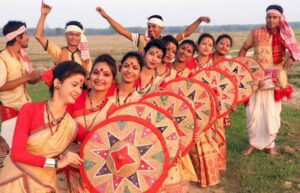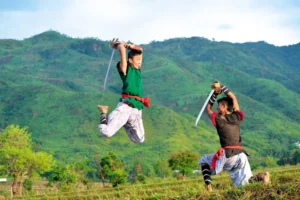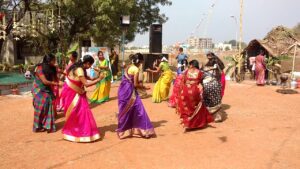Indian Folk dances
Folklore and myths prevalent in different parts of In Indian art and culture India have created a rich tradition of arts mixed with local song and dance traditions.
The folk-dance discipline is generally the Annagarh of Savatta. Presented by people without any formal training Due to this simplicity, an inherent beauty of this art science is achieved. In Indian art and culture These art scholars have been confined to a particular class of people or a particular place from which their knowledge has been transferred from generation to generation.
India is a country in the world where there are diverse traditions and dance, festivals, customs which make the unique tradition of this country famous in the world. Indian folk dances reflect the cultural heritage and vibrant form through dance songs. Each region of India has its own unique dance forms. Which appear to be associated with local festival celebrations and rituals. which seem to be connected to customs and festivities surrounding local festivals.
Indian folk dances are known for their simplicity and relatability to everyday life; they frequently feature themes of the natural world, mythology, and current social affairs. For instance, Gujarat’s Garba and Dandiya Raas, well-known for their rhythmic steps and use of sticks during the Navratri festival, are lively and energetic dances performed during the harvest festival of Baisakhi. Meanwhile, Punjab’s Bhangra is a lively and energetic dance. Indian folk dances not only entertain but tell the rich heritage of the nation through a story.
Some of the famous Indian Folk dances are as follows:
The word Chhau is derived from Chhaya which means shadow. It is a form of mask dance that uses powerful material movements to narrate mythological stories. Some stories also use natural central expressions, such as the sarp dance or the peacock dance
There are three main styles of Chhau dance: Seraikela Chhau in Jharkhand
Mayurbhanj Chhau in Odisha
Purulia Chhau in West Bengal
In 2010, Chhau’s name was included in the UNESCO 7 Representative List of Cultural Heritage of Humanity.
Garba Indian Folk dances
A Gujrati dance in which each woman dancer has a pitcher on her head. In Indian art and culture Garba actually means ‘garba lamp’, an earthen pot with a hole in which a lamp was lit. Around which the women decide the policy in a circular motion on the rider of rhythmic applause. Dandiya Raas

Raas is an energetic and interesting dance form using polished sticks or dandis, depicting a proxy war between Durga and Mahishasura. Dandiya Raas
Raas is an energetic and interesting dance form using polished sticks or dandis, depicting a proxy war between Durga and Mahishasura. Rainbow dresses are used with multi-coloured flags and paper ribbons to enlighten a spectacular sight. Ghoomar or Gangour
It is a traditional folk dance performed by the women of the Bhil tribe in Rajasthan, characterised by the women walking around and making the multi-coloured trembling of the flying Ghaghre look spectacular. Kalbelia Indian Folk dances
It is a soulful dance performed by the women of the Kalbelia community of Rajasthan, in which the dresses and dance movements resemble a snake.
Bean (An instrument played by snake charmers) is a popular instrument of this dance form. In 2010, UNESCO included Kalbelia folk songs and dances on its representative list of the Intangible cultural heritage of humanity.
Charba Indian Folk dances
It is a popular folk dance of Himachal Pradesh performed during the celebration of Dussehra.
Bhangra is a very energetic folk dance of Punjab. Performed to the beat of provocative drums, the dance is popular during festivals.Dadra
In Indian art and culture It is a Semi Classical form of dance popular in Uttar Pradesh, which is jugalbandi with the same type of music. It was highly popular among the court dancers of the Lucknow region. Jawara is a popular crop harvesting dance in the Bundelkhand region of Madhya Pradesh, in this dance, a basket full of jowar has to be kept balanced on the head.
It uses explosive music.Matki is performed by the women of the Malwa region during marriages and other festivals. It is presented only in which many earthen pots are balanced on the head. Ada and Khada Naach are popular adaptations of Matki dance. Gaur Maria (buffalo horn)
In Indian art and culture Gaur Maria is an important disciplinary routine of the Muria tribe living in the Bastar region of Chhattisgarh, in this dance the movements of buffaloes are followed. Alkap is a rural dance-drama performance prevalent in the Rajmahal hills of Jharkhand and Murshidabad and Malda regions of West Bengal.
It is performed by a troupe of 10 to 12 dancers Accompanied by one or two lead singers known as Gayane. The group presents popular folk tales and mythology. In which dance is performed in combination with comedy dramas known as Kap. In Indian art and culture This dance is associated with the Garjan festival related to Shiva. A folksong depicting separation of lover
Biraha Indian Folk dances
Biraha dance with its variation among foreigners is a popular medium of entertainment in rural Bihar, it describes women with whom they are away from home. This mode of dance is presented entirely by men. Women also play the role of characters. Paika is a martial folk dance performed in the southern parts of Odisha. Paika is the name of a type of long spear.
The dancers are armed with wooden spears and shields and display their skills and agility in groups of foot groups.It has the character of martial arts. The word Paika symbolises war. Bagurumba dance is a folk dance performed by the Bodo tribe of Assam and is related to nature and environment. The musical instruments that accompany the Bagurumba performance are Sefung, Kham, Sarja, etc.
Jat-Jatin Indian Folk dances
Jat-Jatin is popular in the northern parts of Bihar and especially in Mithilanchal, this dance form presents the love and sweet exchange between a married woman in a unique way. Chandelier or Jhumhar is a popular harvesting routine performed by the tribal people of Jharkhand and Odisha.
It has two variations, the Janani chandelier which is presented by women and the masculine chandelier which is presented by men, which is the main attraction of many fairs and festivals.
Danda Jaatrama Indian Folk dances
Danda Natra or Danda Jatra is one of the oldest folk arts of India. This dance, famous in odisha, is a unique blend of dance, drama and music. Although the stories of Shiva are presented in it, its central idea is so silly harmony and brotherhood.
Bihu Indian Folk dances
Bihu is a famous dance of Assam performed by both men and women. Dancers dress up in traditional colourful attire to express pomp and gaiety. The slop performance of this dance involves group formation, fast movement and agile steps. Thang Ta: Manipur’s special battle is continuous.

Thang Ta Indian Folk dances
Thang ta means sword and Ta means spear, it is a unique display of sustained performance, skill, creativity and agility, in which performers perform a simulated battle sequence, leap to attack, defend.

Ragama Indian Folk dances
Rangama is the war dance of the Nagas. In Indian art and culture Dancers dressed in colorful costumes, ornaments and headstrings perform without performing martial patterns and traditions.
Singhi Chham Indian Folk dances
Singhi Chham is a popular mask of Sikkim Nirukta. The dancers are dressed in fur robes, symbolise the snow lion and pay homage to Khang Chen Jong Pa.
Kummi Indian Folk dances
Kummi is a popular folk dance of Tamil Nadu and Kerala region. It is continuously performed by women standing in a circle pattern. A unique feature of this continuous performance is that it does not have any kind of music.The rhythm is generated by loud applause. This dance is performed during Pongal or religious activities. Kolattam is a close weapon adaptation of this dance form.

Mayilattam Indian Folk dances
Mayilattam is a folk dance of Kerala and Tamil Nadu in which young women dress up as peacocks with colourful hair, beaks and feathers.
Butta Bommalu Indian Folk dances In Indian art and culture
Butta Bommalu means basket toys the famous dance dancers from West Godavari district of Andhra Pradesh wear masks of different characters who have matching toys and entertain with delicate drivers and wordless music
Kaikottikali Indian Folk dances In Indian art and culture
Kaikottikali: This is a popular temple in Kerala. It is performed by both men and women during Onam with a good harvest. Arukali and Tatamakali are similar forms of this dance.
Padhyani Indian Folk dances In Indian art and culture
Padhyani:A martial art dance performed at the Bhagavathy temples in southern Kerala, Padiyani means infantry lines and is a highly rich and colorful dance. Dancers wear huge masks called kolam. Kaolakali-Parachakali It is a popular martial art dance in the regions of South Kerala and Lakshadweep
Kol means stick and Parichaa means shield.
The dancers use camouflages made of wood and act in a series of battles. The performance starts slowly, but gradually the pace increases, and the end is frenzied.
Pata Kunitha Indian Folk dances
Pata Kunitha It is a popular dance form of the Mysore region, it is a religious dance performed mainly by men using long bamboo poles sliced with a colorful ribbon known as Patta. The abundance of colors makes it a spectacle. It is very popular among people of all religions. Pooja Kanitha is an adaptation of this dance form which is popular in the surrounding areas of Bengaluru and Mandia districts.
Chakyar Koothu Indian Folk dances
Chakyar Koothu It is an art form of Kerala. It is a solo dance in which the performers adorn themselves like snakes. It is a combination of prose and poetry and is described in Malayalam.
Punjab dance jhoomar Indian Folk dances In Indian art and culture
Artists wear colorful caps or turbans, large black moustaches and red spots on their bodies
Jhoomar This dance is performed by Sikh in Punjab and surrounding areas during the harvesting season.
It is performed in a circle. Be it the movement of hands or shoulders to the beat of drums, the most important part is the costume similar to Bhangra. It was brought to India from Balochistan by traders.

Karma Indian Folk dances
Karma Dance is danced during the tribal festival ‘Karma’ by many tribes in eastern India, especially in the plateau of Chota Nagpur. The dancers form a circle and dance by putting their hands around each other’s waists.
Raut Naach Indian Folk dances
It is performed in Chhattisgarh by the Yadav community especially during the festival of Diwali.
Dumahal: This dance is performed by the Wattal tribe in Jammu and Kashmir.
It consists of colorful costumes for men with a long-narrowed cap, performers dancing and singing to the beat of drums
Fugdi: Performed by ladies in the Konkan region of Maharashtra and Goa during the festival It dances in different structures in circles and rows, according to local traditions it has many sub-types.
Cheraw Indian Folk dances
It is a folk dance of Mizoram, it is performed with bamboo sticks, its origin is foreign.
Dalkhai Indian Folk dances
It is a tribal dance performed mainly on the festival of Dussehra in Odisha in which many musical instruments are used to depict the events of Ramayana, Mahabharata and stories of Lord Krishna etc. The word girlfriend is used at the beginning and end of every verse.
Hulivesha Indian Folk dances
Performed in coastal karnataka, hulivesha involves male dancers dressed like vaghas. Who dance and take the form of an angry tiger to honour goddess durga, whose favourite animal
Is the tiger. It is commonly performed during the festival of navratri.
Comment
In Indian art and culture Originating from the Saurashtra region of Gujrat, it is performed exclusively by women. They beat the floor with a stick (Two long sticks joined by a square wooden or iron block) to the beat of our folk song.
Gardi: It is a famous folk dance of Puducherry and performed to celebrate the victory of Lord Rama and Ravana. Dancers adorn themselves as monkeys celebrate this victory, dancers wear 10 “Anjali” iron rings on each of their legs.
Teratali is performed by the Kamar tribe of Rajasthan. In Indian art and culture, The women sit on the ground performing Teratali. Jhanjh instruments are tied to different parts of the artist’s body which is quite unique
Hojagiri: Indian Folk dances
Hojagiri, a famous folk dance of Tripura, involves movements of only the lower half of the body by a group of four to six women or young girls. The female dancers balance the dancing time as well as other things.
Conclusion
These folk dances reflect the diverse cultural heritage In Indian art and culture. Each region in India displays its unique traditions with these dances by rhythmic movements, colorful costumes and traditional music.
These dances, which have their roots in customs, festivals, and everyday life, represent the histories, values, and tales of diverse communities. Indian folk dance, from the exuberant Bhangra of Punjab to the elegant Kathakali of Kerala, is a generation-to-generation celebration of life and culture. In Indian art and culture These performances help India’s diverse populations feel united and proud of one another in addition to preserving cultural identity.
